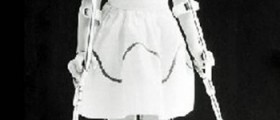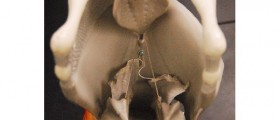
Poliomyelitis or infantile paralysis often abbreviated as polio is an acute infectious disease caused by Poliovirus . It is very contagious and spreads by oral-fecal way.
In 90-95% of cases, infection does not cause any symptoms. Deaths are possible when paralysis aggravates normal breathing and swallowingPoliomyelitis usually attacks children aged 3 to 8. It has been considered as an endemic disease for thousands of years until 1880 when in Europe and then in North America caused an epidemic brake out.
Poliomyelitis is divided into paralytic and nonparalytic forms. 1. Paralytic forms are manifested as limp paralysis. According to the paralysis topography varies more clinical forms: Nonparalytic forms Spinal limbs paralysis is the most common form of the disease. It is characterized by muscle paralysis which starts from the spinal cord (except for respiratory muscles). Invasive stage usually lasts a few hours or one to five days passing through three stages initial latent and manning adynamic. The initial stage lasts for 2-3 days. The child suddenly began to complain of malaise, headache and pain in extremities. The symptoms of the digestive tract can be observed -nausea, vomiting, diarrhea. Sore throat and cough also can appear. All these problems can be so light that can pass unnoticed.
Latent phase lasts for one to two days and it is asymptomatic.
Manning adynamic phase include penetration of large virus amounts in the blood. It begins with a high temperature up to 40 ° C and pain in muscles and joints, headache, sweating and enervation. By clinical examination is noticed adynamia, glowing face with paleness around the mouth and easy cyanosis of lip - poliomyelitica facies. Neurological symptoms are expressed and meningeal signs are almost always present. Tendon reflexes may be weakened and less short-term enhanced.
Paralytic stage is characterized by the appearance of irresolute paralysis. Paralysis occurs mainly in the first 48 to 72 hours. They are lose and peripheral, accompanied by areflection. Sensitivity is preserved, but muscle soreness is expressed. Paralyses usually occur on the lower extremities. The upper limbs are rarely affected usually proximal. Usually, this form does not endanger the patient’s life. With cessation of new polios begins a phase of withdrawal symptoms.
Withdrawal paralysis stage starts 10 days after the appearance of paralysis. In the beginning, symptoms withdraw quickly, and then more slowly and it can be extended to a year. First draw paralysis that occurred last. Respiratory polio is characterized by respiratory insufficiency. Usually appears the following forms: Spinal form with breathing paralysis includes the chest abdominal muscles and diaphragm singly or in combination, leading to breathing disorders. The disease has a rapid course and tracheotomy and application of artificial ventilation are often required.
Bulbar polio with swallowing paralysis is the result of the process localization in the extended marrow and Pons, wish affects respiratory centers and nuclei of large cerebral nerves. It is clinically manifested as disorders of the central breathing and swallowing paralysis. The patient is not able to swallow and expectorate the secretion.
Spin-bulbar polio includes swallowing paralysis associated with respiratory muscle paralysis. It is accompanied with secretion flooding of respiratory tree.
Encephalic polio includes high fever, convulsions and disorder states of consciousness. 2. Nonparalytic forms include:
Initial phase clinically runs without any subjective and objective symptoms, the greatest number of people not knowing gets over infection. Febrile phase is manifested as summer children's diarrhea. Stools are fluid, green, slimy, and there are 6-8 per day. The disease lasts for 6-7 days. Meningeal phase is manifestats as a serious viral meningitis etiology.















-And-Breathing-Problems_f_280x120.jpg)
Your thoughts on this
Loading...